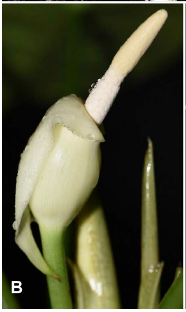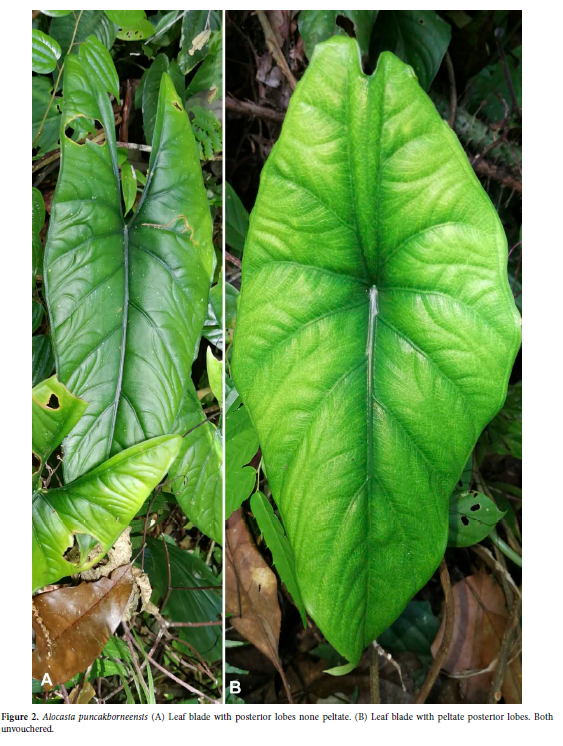ALOCASIA PUNCAKBORNEENSIS*
ORIGINAL DESCRIPTION:
Alocasia puncakborneensis S.Y.Wong & P.C.Boyce, sp. nov.
Type: Malaysian Borneo, Sarawak, Kuching, Padawan, Puncak Borneo, trail to Batu Panggah, 1°07’37.0”N 110°13’47.5”E, 838 m asl. 15 May 2019, Wong Sin Yeng & P. C. Boyce AL- 80 (holotype SAR!; isotype KEP!)
Photo by LasPlantas.ID
SYNONYMS: N/A
DISTRIBUTION: Malaysian Borneo, Sarawak, Kuching, Padawan, Puncak Borneo,
CLIMATE: Tropical humid climate
Humidity is moderate throughout the year, ranging from 60% to 70%
Temperature is varies between the seasons - within the range of 48°F/9°C to 88°F/31°C during the day. Minimum temperatures never dip below 45°F/7°C
Rainy and humid season (October to May) and a dry season between June and October. The average annual rainfall is 1,200 mm
ECOLOGY: Occurring as localised small populations and occasional individuals throughout the higher reaches of the Penrissen Range, never below 800 m, and extending to about 1300 m asl. Terrestrial or facultatively lithophytic on steep shaded slopes or on damp boulders under moist upper hill forest on Paleogene sandstones, between 880–1170 m asl.
SPECIES DESCRIPTION:
Small herb to ca 55 cm tall; rhizome initially condensed, erect, later elongating and decumbent, ca 3 cm diam.; leaves several together, irregularly interspersed with slightly fleshy pale green, later marcescent brown lanceolate cataphylls to ca 9 cm long; petioles 10–45 cm long, ca 5 mm diam., semi glossy pale green sheathing in the lower ca 10–15%; blades thinly leathery, in adult plants all peltate or mixed peltate and non-peltate, only very occasionally entirely non-peltate, ovate to rather narrowly ovato-sagittate, 10 × 4 cm to 35 × 11–12 cm, widest at or slightly distal to junction of petiole, glossy brilliant green with the adaxial surface densely and finely raised-reticulate; anterior lobe acute, with the tip abruptly acuminate for ca 1 cm; anterior costa with 3–4(–5) primary lateral veins on each side, diverging at ca. 90° proximally, the distal ones at ca 60°, running almost straight to the margin and joining a submarginal vein; axillary glands not conspicuous; secondary venation fine, forming a rather vague interprimary collective vein, very slightly impressed adaxially, flush with the lamina abaxially but slightly darker and thus visible; tertiary veins forming a fine reticulum, prominently raised adaxially, flush abaxially; posterior lobes about 1/5 the length of the anterior, united for 75–90% of their length, or free, when maximally united the base of the blade slightly rounded except for an acute to rather obtuse notch; posterior costae diverging at ca 15° when blade peltate, or at ca 30° when not peltate, so posterior lobes not widely divergent, and naked in the sinus for ca 2 cm;
INFLORESCENCE:
Inflorescences 2–4 together, subtended by lanceolate rather fleshy cataphylls, these later briefly marcescent, brown; peduncle ca 10 cm long at anthesis, extending to about twice this during fruiting; spathe ca 6 cm long; lower spathe ca 2 cm long, ovoid, semi glossy white; limb semi glossy white on both surfaces, at first erect, then sharply deflected, oblong lanceolate, mucronate for ca. 6 mm; spadix slightly shorter than the spathe, stipitate for ca 3 mm, stipe semi glossy white; pistillate zone ca 1 cm long; pistillate florets somewhat lax, flask-shaped, ca 1.5 mm diam., facing obliquely upwards, ovary pale green, the stylar region somewhat darker; style slender, ca 0.5 mm long, in a few florets absent; stigma 2-lobed, white and shining/sticky; sterile interstice ca. 4 mm long, slighly attenuated, situated within the chamber of the lower spathe, lower synandrodia irregular in shape, ca. 2 mm diam., upper ones rhombo-hexagonal; staminate zone ca 2 cm long, 4 mm diam., subcylindric, slightly constricted ca 1/3 from the base corresponding to spathe constriction; synandria rhombo-hexagonal ca. 2 mm diam., 4-6-merous, the thecae opening by apical pores, synconnective not expanded beyond the edge of the synandrium; appendix about isodiametric with staminate zone, ca. 2 cm long, gradually tapering to a blunt point, appendical staminodes irregularly polygonal, pale cream; fruiting spathe broadly ovoid, ca. 2 cm long, brilliant white, remaining erect, persistent lower spathe splitting longitidinally into about three segments; berries bright scarlet.
VARIEGATED FORMS: N/A
ETYMOLOGY: The specific epithet is from the Type locality plus the suffix -ensis, indicating ‘from’. Puncak (summit of a mountain in the Malay language) is pronounced pun-CHAK, with emphasis on the second syllable.
NOTES:
Alocasia puncakborneensis falls uncontroversially in the Alocasia princeps Complex by the thinly leathery leaves, sequentially produced blooms not interspersed with foliage leaves, the staminate portion of the spadix partially enclosed within the lower spathe chamber, and the acroscopic pistils. Alocasia puncakborneensis is distinguished from all described species of the complex by the brilliant green leaf blades with the tertiary veins forming a prominently raised fine reticulum on the adaxial surface.
Alocasia puncakborneensis occurs at the highest altitude of any of the locally-restricted/geologically obligated species yet described for the Princeps Complex. Six of the eight hitherto known species are lowland species, exceptionally occurring up to 600 m asl, and mostly much lower, and are obligated to Karst limestone (Hay 1998). Three of these species occur in Sabah (Alocasia pangeran A.Hay, Alocasia principiculus A.Hay, Alocasia puteri A.Hay), one in east Sarawak (A. venusta A.Hay), and two in SW Sarawak (Alocasia reversa N.E.Br., Alocasia ridleyi A.Hay). One of the remaining species, Alocasia wongii A.Hay, occurs across quite a wide area of east Sabah, usually at low altitudes on sandy sedimentary-derived substrates, although occasionally occurring on limestone. As currently defined Alocasia princeps W.Bull is widespread throughout middle and east Borneo at up to 1200 m asl, is ecologically highly inconstant, and morphologically rather variable. Detailed field studies will in all likelihood reveal the current concept to consist of more narrowly defined taxa (see Hay 1998 for more detailed discussion).
CULTIVARS: N/A
HYBRIDS: N/A















